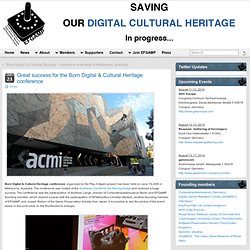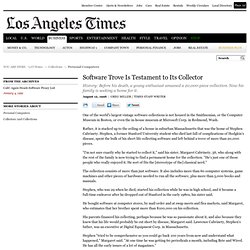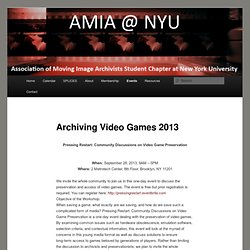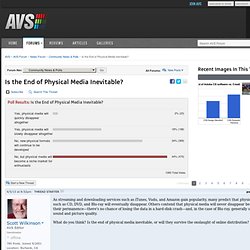

Conference report. [ By Melanie Swalwell on July 25, 2014 | Filed under: Blog ][ No comments yet ] On the 19th and 20th June, 2014, the Play It Again team welcomed a fabulously diverse group of scholars and practitioners to Melbourne’s Australian Centre for the Moving Image for the Born Digital and Cultural Heritage conference.

In attendance were Humanities and Computer Science researchers, lawyers, archivists, conservators, librarians, game and net.art preservationists, game developers, and a bunch of interesting others besides. Great success for the Born Digital & Cultural Heritage conference » EFGAMP. Born Digital & Cultural Heritage conference, organized by the Play It Again project, has been held on June 19-20th in Melbourne, Australia.

The conference was hosted at the Australian Centre for the Moving Image and received a huge success. The conference saw the partecipation of Andreas Lange, director of Computerspielemuseum Berlin and EFGAMP founding member, which chaired a panel with the partecipation of SPS/Kryoflux Christian Bartsch, another founding member of EFGAMP, and Joseph Redon of the Game Preservation Society from Japan. It is possible to see the photos of the event below in this post (click on the thumbnails to enlarge). In the picture: Melanie Swalwell (Conference Chair, Flinders University Adelaide, Project Leader Play it again) (from left): Shane Farrow (New Zealand Film Archive), Andreas Lange (Computerspielemuseum), Henry Lowood (Stanford Libraries), Melanie Swalwell (from left): Joseph Redon (Game Preservation Society Japan), Henry Lowood, Andreas Lange) Museums and the Digital. I was lucky to hear from Henry Lowood at the Brown Bag at the Australian National Maritime Museum this week.

Henry is from Stanford University, leading the project How They Got Game dedicated to the archival preservation of digital games and simulations, and was keynote speaker at this year’s Born Digital and Cultural Heritage Conference at ACMI. Digital games have existed since the dawn of modern computing, dating back to the 1970s running on long-obsolete hardware and software platforms, and have been a part of our world’s cultural landscape for over a generation.
Here‘s a brief presentation of work being done with one such collection from Stephen M. How will historians study videogames? Since their birth as a science fair curiosity at Brookhaven National Laboratory in the late 1950s, video games have moved inexorably towards higher and more central cultural ground, much like film did in the first half of the 20th century.

Software Trove Is Testament to Its Collector. One of the world's largest vintage software collections is not housed in the Smithsonian, or the Computer Museum in Boston, or even the in-house museum at Microsoft Corp. in Redmond, Wash.

Rather, it is stacked up to the ceiling of a house in suburban Massachusetts that was the home of Stephen Cabrinety. Stephen, a former Stanford University student who died last fall of complications of Hodgkin's disease, spent the bulk of his short life collecting software and left behind a trove of more than 20,000 pieces. "I'm not sure exactly why he started to collect it," said his sister, Margaret Cabrinety, 36, who along with the rest of the family is now trying to find a permanent home for the collection. "He's just one of those people who really enjoyed it.
AMIA Student Chapter at NYU. Pressing Restart: Community Discussions on Video Game Preservation When: September 28, 2013, 9AM – 5PM Where: 2 Metrotech Center, 8th Floor, Brooklyn, NY 11201 We invite the whole community to join us in this one-day event to discuss the preservation and access of video games.

The event is free but prior registration is required. You can register here: Digital Preservation Tool Grid. This tool grid is the product of researching digital preservation tools by Digital POWRR team members in early 2013.

The information included is accurate to the best of our knowledge, but some information may be incorrect or have changed. We learned the information from various sources including tool websites, contacting the tool developers directly, discussion boards, and some direct tool testing. To learn more details about a tool click on the tool name.
The categories and some cost cells will show more information if you hover your cursor over that cell.
Video Game Preservation at Scale: An Interview with Henry Lowood. For a while now, Stanford University’s special collections have had the distinct honor of holding “one of the largest historical collections of interactive software in the world.”

The Stephen M. Cabrinety Collection in the History of Microcomputing at Stanford University consists of several thousands of pieces of computer hardware and software. At a recent advisory board meeting for the ongoing Preserving Virtual Worlds project, I was thrilled to hear from Henry Lowood, Curator for History of Science & Technology Collections and Film & Media Collections in the Stanford University Libraries, that Stanford had entered into a partnership with NIST’s National Software Reference Library to disk image and digitize related materials for a large portion of the collection.
I’m thrilled to have this opportunity to discuss this project here with Henry. Is the End of Physical Media Inevitable? Vinyl lives, though it's no longer what it used to be.

The quality of actual material used to make it, the limited availability of quality lathes, etc. all yield a poorer product than what we saw just a few decades ago. The market has broken apart into those who prize flexibility over quality. So, we'll continue to see the growth of streaming over physical media. Yet, as shown by some distributors, like HDtracks, there is clearly a market for quality downloads. It's just selective. I'd hoped to see Blu-Ray become a medium for high quality audio, but that hasn't happened.
And over time, if people invest more in home systems, that don't simply put their main emphasis on video at the expense of audio, we'll see a burgeoning of demand for more overall quality. And our reliance on access to media streaming any time we want is not like turning on the tap for water. Libraries preserves historical software collection with Federal Agency. Preserving Video Game History, One Byte at a Time.